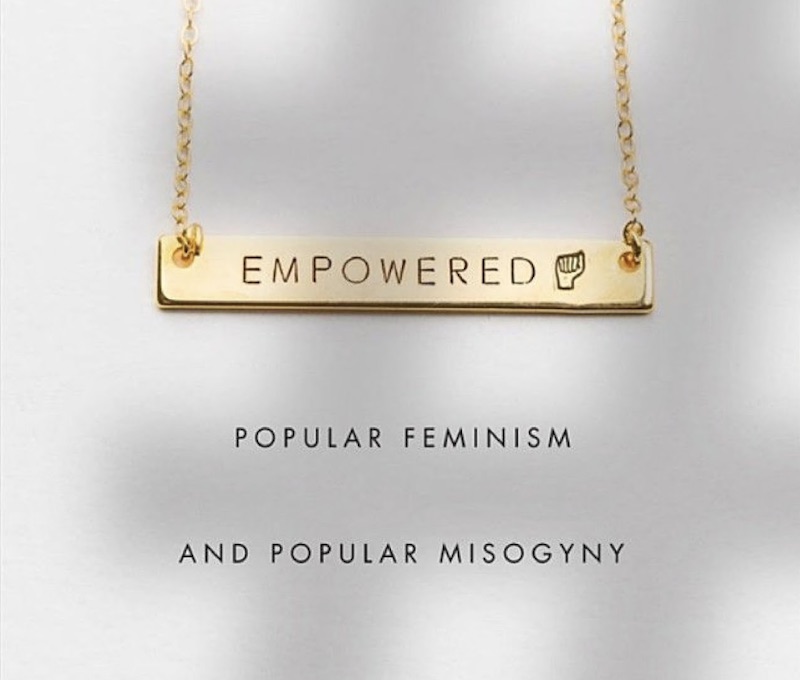Has Popular Feminism Failed Us All?
Instead of “feminism that is ‘all the rage,’ we need an intersectional, collective rage," argues Sarah Banet-Weiser in her book "Empowered." Duke University Press
Duke University Press
Purchase in the Truthdig Bazaar
“Empowered: Popular Feminism and Popular Misogyny”
A book by Sarah Banet-Weiser
In May 2014, I went to a “Sexism Workshop” at the Centre for Feminist Research at Goldsmiths, a college in the University of London system. “Sexism,” the organizers explained, “is a problem with a name. Sexism is the name that feminists have used to explain how social inequalities between men and women are reinforced or upheld through norms, values, and attitudes.” The Centre’s then-director, Sara Ahmed, a self-proclaimed “feminist killjoy,” and her colleagues pulled together the event because they thought that while more feminist activists and journalists were writing about sexism, academics were not talking about it enough. The Everyday Sexism Project, a website started in 2012 by Laura Bates to encourage people to share their experiences with sexism, drew over 100,000 entries in 13 languages in the first three years of its existence. Yet, in the organizers’ words, “although critiques of sexism as structural to disciplines were central to early feminist work in the academy, if anything the concern with sexism, or the use of the language of sexism, seems to have receded.”
In her talk at the workshop, the cultural theorist Angela McRobbie, a professor at Goldsmiths, expressed concern about young women who conform to traditional standards of femininity by waxing their bikini area or threading their eyebrows while insisting, “I’m doing it for me!” To her, these women were suffering from a false consciousness, duped into colluding — enthusiastically! — in their own subjugation. This was not a new idea for McRobbie. In her 2008 book, “The Aftermath of Feminism,” she writes:
The successful young woman must now get herself endlessly and repetitively done up […] to conceal the competition she now poses because only by these tactics of re-assurance can she be sure that she will remain sexually desirable. […] And in any case patriarchy and hegemonic masculinities have removed themselves from the scene and are now replaced by the cultural horizon of judgement provided by the fashion and beauty system […] which requires constant self-judgement and self-beratement, against a horizon of rigid cultural norms. This makes it look as though women are “doing it for themselves.”
As McRobbie spoke, a woman in her 20s wearing a white shirt with a rainbow-pony design jumped to her feet and furiously shouted, “When I get my eyebrows done, I am doing it for me!” To McRobbie, the young woman was being fooled by the patriarchy. To the young woman, McRobbie was, as Sarah Banet-Weiser puts it in “Empowered: Popular Feminism and Popular Misogyny,” “a finger-wagging ‘bad mom’ feminist that doesn’t understand the younger generation.” To me, they both had a point. Intergenerational feminism is tricky, and we need books that do more than criticize — we need books that forge new connections and suggest new paths. Unfortunately, “Empowered” is too long on critique and too light on fresh ideas.
Click here to read long excerpts from “Empowered” at Google Books.
The complexities of cross-generation feminism are summed up by that trope of popular culture, the “bad mom feminist,” washed up by the second wave. Think of Offred’s mother in “The Handmaid’s Tale,” a single mother by choice, an anti-porn and pro-abortion rights activist who didn’t think her daughter was feminist enough. “You’re just a backlash. Flash in the pan,” she tells her daughter. “You young people don’t appreciate things […] Don’t you know how many women’s lives, how many women’s bodies, the tanks had to roll over just to get that far?” Offred is resentful, thinking: “She expected me to vindicate her life for her, and the choices she’d made […] I didn’t want to be the model offspring, the incarnation of her ideas.”
Lily Tomlin often plays these characters in movies, from Tina Fey’s tough, free-spirited single mom in the 2013 movie “Admission” to the title character of the 2015 film “Grandma,” a film by the same director, Paul Weitz. In “Grandma,” Tomlin plays the same second-waver single-mom rabid hippie feminist, but she is a lesbian this time, and she disapproves not only of her daughter, a successful businesswoman who, clad in a pink power suit, represents 1980s-style liberal equality feminism, but also her college-aged granddaughter, who thinks “The Feminine Mystique” refers to an X-Men character and who comes to her asking for help getting an abortion. Weitz sees the grandma as a fighter for women’s equality, her daughter as a product of it, and the granddaughter as a representation of the “erasure of women’s history in the minds of young people now.” Young women are often depicted as naïfs in need of a feminist education, but also, as rightfully resentful of the bad mom feminists who lecture when they should be loving.
These older feminists desperately want to show the younger generation how bad it used to be, and how much work they did to get here, and how we are not in a post-feminist age. These older feminists turned many “invisible” problems into visible ones — sexual harassment, marital rape, workplace discrimination. Does it need to be quoted here? Maybe not, but I will anyway: in her 1963 book “The Feminine Mystique,” Betty Friedan called the widespread unhappiness of many American women trapped in domesticity “the problem that has no name.” Many women thought their unhappiness was just an individual problem, but it was, Friedan argued, a collective, structural, political problem.
A lot of the work of feminism is making visible what was once hard to see — for those privileged enough not to have seen it before. That is why these second-wavers are so angry, so passionate — they had a lot to make visible — and why they are depicted as both noble and out of touch in an age in which people wear T-shirts that proclaim feminism, companies use feminist buzzwords to sell things, and Beyoncé performs in front of a screen emblazoned “FEMINIST.” But this newer kind of feminism, Banet-Weiser argues in “Empowered,” does not run deep. “Popular feminism exists most spectacularly in an economy of visibility, where it often remains just that: visibility,” she warns us. “Popular misogyny, on the other hand, seems to fold into state and national structures with terrible efficiency.” The work of feminism, and more specifically the work of this book, is to continue the muckraking aspect of feminism by exposing the workings of misogyny but also to reach for different feminisms that are less concerned with mere visibility: more constructive, creative, deeper. “Empowered” pursues these twin goals with mixed results.
The book opens with an appeal to intergenerational feminism. Banet-Weiser dedicates it to her mother, who “taught me the two crucial things about life: believe in yourself, and don’t take shit from anyone.” She begins the book with the story of how, on Trump’s election night, she tried to comfort her 15-year-old daughter, who “moved from a position of empowerment to one of a frightened child” as a racist and misogynist became president. Banet-Weiser, a professor of Media and Communications at London School of Economics who focuses on gender in the media, depicts herself as both an inheritor and a passer-down of feminist knowledge in her teaching as well as her parenting. It is a strange time, though: “after so many years of defending feminism to others, and struggling to make it visible,” this visibility thing has gone too far.
“Popular feminism” is “popular” in three ways to Banet-Weiser: it attracts fans; circulates in popular and commercial media like Twitter, blogs, and broadcast media; and — as she explains via the cultural theorist Stuart Hall — serves as a site of contestation. The first seems most important to her; Banet-Weiser is concerned about the ways in which popular feminism defangs itself in order to be more accommodating. “Popular feminism,” she writes, is “fun.” “Popular feminism is decidedly not angry — indeed, anger (at sexism, racism, patriarchy, abuse) seems to be an old-fashioned vestige, a ghost of feminism’s past.” Angry feminists, she argues, are seen as “bad mom” feminists who don’t understand kids today and their popular feminism. Instead of getting at the roots of problems, “popular feminism tinkers on the surface, embracing a palatable feminism, encouraging individual girls and women to just be empowered.” Girls and women should just love themselves and their bodies and forge confidently into the future.
Drawing on other theorists, including McRobbie, Banet-Weiser argues that this idea of empowerment is predicated on a neoliberal idea of turning girls and women into productive economic subjects, not on any desire to change the system. Instead, she argues that, “popular feminism can be seen as a kind of backlash against feminism’s goals of critiquing racism, capitalism, and patriarchy (and their deep relations).” “By commodifying and making feminism ‘safe,’” she concludes, “popular feminism resists structural critique.”
In one chapter, Banet-Weiser demonstrates this point by discussing four different examples of popular feminism: a YouTube series created by a nonprofit organization, Girls Who Code; a Verizon ad; a 2015 documentary entitled GTFO (about #GamerGate); and a Twitter hashtag campaign — #timhunt — that called out the eponymous male scientist who said women in science labs were “distractions” for men. Banet-Weiser finds most of these examples lacking. The YouTube series by Girls Who Code, which involved girls saying things like “I can’t code because my cleavage is too distracting” makes for a too-easily-digestible feminism, Banet-Weiser thinks, because of its humor, which she sees as a ploy to make the campaign more popular. She makes similar criticisms of the #timhunt campaign, which involved similar sarcasm, with women scientists tweeting pictures of themselves at work with captions like, “Still #distractinglysexy after a full day of cell culture. Didn’t even cry this time, so proud!” Banet-Weiser also maintains that the #timhunt campaign was too focused on an individual sexist and not the wider problem of sexism.
I agree that one should not overlook the systemic nature of oppression, but I think Banet-Weiser is selling humor short. She argues that jokes disappear from our feeds more quickly because they are jokes, and that this is how an “economy of visibility functions; rather than a politics of visibility, where the visibility itself is a route to politics, visibility becomes enough in itself.” But humor can grab our attention in a way lecturing can’t: serious attempts, like the Verizon ad and “GTFO” documentary she discusses and like this book itself, can sometimes seem dismissible because they are telling us about a problem we already know exists. Humor introduces an uncomfortable disjunction between content and form. It also creates an in-group of people who are laughing at the joke and an out-group of those who aren’t — in this case, sexists. In the Girls Who Code YouTube series, one girl says, “I don’t even have boobs yet and they still get in the way. It’s crazy.” If sexism is crazy, isn’t humor one of the best ways to point that out?
The Verizon ad, designed to get more girls interested in STEM, features a white girl who is discouraged by her parents from fixing things and ends with the tagline “Isn’t it time we told her that she’s pretty brilliant too.” Banet-Weiser very rightly points out that the ad still stresses the importance of being “pretty” and — again — bolsters neoliberalist individualism, blaming the girl’s parents for her lack of involvement in science instead of, say, a patriarchal system. Banet-Weiser is most positive about the documentary “GTFO,” which she praises for focusing on the system rather than individuals and showing how problematic it is for the gaming industry to consider itself “depoliticized” when it churns out violent, sexist products. Yet her discussion of the film would have been better positioned at the end of the chapter as a more positive example. Indeed, the chapter (like the book as a whole) misses the opportunity to showcase alternatives to popular feminism — alternatives that would allow Banet-Weiser to more deeply consider what feminism might mean to different generations.
“Empowered” would also have benefited from a fuller and more nuanced examination of misogyny. Banet-Weiser writes that the “popular” in “popular misogyny” is reactive, but that makes her discussion of misogyny seem like an afterthought. While popular feminism, for Banet-Weiser, is too visible, she calls popular misogyny “a norm, invisible, commonplace.” Fighting misogyny, therefore, requires making the invisible visible, but this book doesn’t do enough of that kind of work. Indeed, I was surprised by her lack of engagement with an influential recent book by the feminist philosopher Kate Manne, “Down Girl: The Logic of Misogyny,” which came out in November 2017, a year before “Empowered.” Banet-Weiser calls popular misogyny “the instrumentalization of women as objects, where women are a means to an end: a systematic devaluing and dehumanizing of women.” In “Down Girl,” Manne refutes this common idea of misogyny, writing:
[T]he failure to recognize women as human beings need not, and often will not, underlie misogyny […] The key contrast naturally shifts to the second part of the idiom instead. Women may not be simply human beings but positioned as human givers when it comes to the dominant men who look to them for various kinds of moral support, admiration, attention, and so on. She is not allowed to be in the same ways as he is. […] [I]f she errs on this score, or asks for something of the same support or attention on her own behalf, there is a risk of misogynist resentment, punishment, and indignation.
Manne’s insightful analysis here might have aided Banet-Weiser’s discussion of, for example, #GamerGate. In “Empowered,” she analyzes the “toxic geek masculinity” evinced by #GamerGate, arguing that geeks are mad because “women are not doing what they are supposed to do (partner with geek men), and then they are doing what they are not supposed to do (work in the technology industries).” This is an excellent illustration of the misogynistic demand on women to be “human givers” instead of “human beings.” At moments like this, Manne’s definition might have helped deepen Banet-Weiser’s understanding of misogyny as a systemic force that extends beyond, and often does not even include, an individual psychology of dehumanization.
Banet-Weiser closes the book by writing that instead of “popular feminism, feminism that is ‘all the rage,’ we need an intersectional, collective rage, directed at a racist and sexist structure. We need a lasting feminist rage.” In other words, we need more of the anger that, as Banet-Weiser rightly says, is often attributed to the “bad mom” feminist. But that kind of rage is popular now too; before “Empowered” came out, we did have a crop of books about feminist rage, including Soraya Chemaly’s “Rage Becomes Her: The Power of Women’s Anger,” which came out in September 2018, and Rebecca Traister’s “Good and Mad: The Revolutionary Power of Women’s Anger,” which came out in October 2018. Chemaly’s Facebook profile describes her as “[w]riting about gender equity with humour.” The younger feminists are angry, and often they are funny too. As Chemaly tweeted recently, seeing anger and optimism as mutually exclusive “ignores anger *as optimism*.” Anger, she explains, “suggests that a person thinks change is possible,” and “that they have a right to demand accountability, or make change themselves.” Let’s all get angry and change things.
Your support is crucial…
With an uncertain future and a new administration casting doubt on press freedoms, the danger is clear: The truth is at risk.
Now is the time to give. Your tax-deductible support allows us to dig deeper, delivering fearless investigative reporting and analysis that exposes what’s really happening — without compromise.
Stand with our courageous journalists. Donate today to protect a free press, uphold democracy and unearth untold stories.









You need to be a supporter to comment.
There are currently no responses to this article.
Be the first to respond.